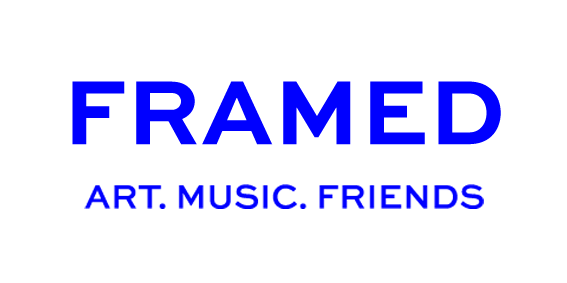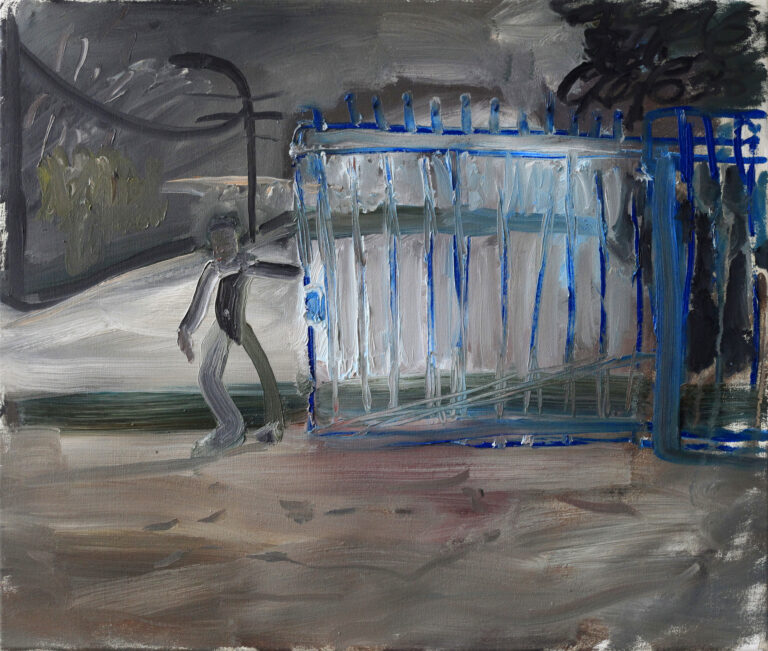I like to explore raw human existence, a story that takes part for the making. The same issues can often reappear in different combinations, like subjects displaying both a rigid facade but always a vulnerable persona with strength and weakness exposed.
OD – it’s always interesting to know how a painter came to become one, could you say something about your attraction towards painting? What drove you to paint? In what kind of context and environment you started as a painter?
JH – I specialised in video and performance for my art degree, and wasn’t fully connected with it so I opened a small coffee shop gallery as I didn’t know what to do next.
My friend got really ill, I had no time to film any more with the shop so I decided to have a go at painting at night, just to do something to release what was going on in my head.
I couldn’t believe the connection I got to actually painting as Id never done it before, it just became me, I sold the shop and I’ve been painting ever since.
A friend saw what I’d been up to and then introduced me to the work of William De Kooning’s, this blew my mind and my obsession became even deeper, I can’t get enough of painting, I love seeing other peoples work too, in the public eye or not, I just breath it all in.
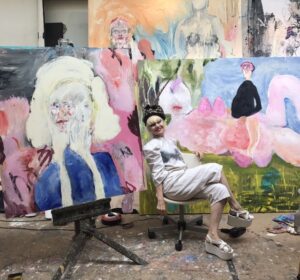
OD – Looking at your paintings one is confronted with creatures both demon and fairy like. They are painted with lascivious, bright and juicy colours, could you say something about this tension? The dynamic between subject matter and matter itself?
JH – I want to make art that speaks to people, I like to paint in bright candy colours to get attention, I think this invites people in. Using a kind of comedy element also to get people in closer, I hope then they get a deeper more uneasy feeling but then it’s too late, you’re already involved.
My work is about the dark and light in life and I’m hoping to get this across, life is confusing, I like to explore raw human existence, a story that takes part for the making. The same issues can often reappear in different combinations, like subjects displaying both a rigid facade but always a vulnerable persona with strength and weakness exposed.
I am interested in the ideas of identity and gender stereotypes, investigating hypocrisies, double standards, my work also highlights our impact on the environment and conflicts inherent to humanity, transcending contemporary existence, body image and sexual expectations that highlights the sexualised and demeaning depiction of women.
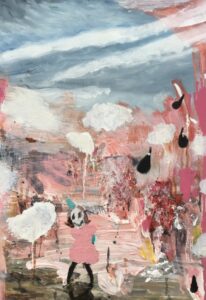
I am interested in the ideas of identity and gender stereotypes, investigating hypocrisies, double standards, my work also highlights our impact on the environment and conflicts inherent to humanity, transcending contemporary existence, body image and sexual expectations that highlights the sexualised and demeaning depiction of women.
OD – There is a strong sense of fragility in your work, things seem to be shaky, trembling and sometimes on the edge of falling apart, dissolving. On the other hand there’s decisivness, at some point you painted them and left them there, as they are.
Could you say something about your painting process? About confusion and decision?
JH – When I start a piece I usually have a bee in my bonnet about something, it could be something I’ve experienced that morning walking down the river, something in a dream or on the news, the flippancy of people in this world, old movies, clowns, I’m also influenced with Goya’s materialistic philosophy as it’s so apt but this is just my starting point, so I’ll have a beginning image.
A painting usually can take anything from a month up to three so all my experiences go in there too, questioning what we are and what it means to live.
I try and paint the feeling I experienced at the beginning with added layering, I’ve no idea what this looks like until it’s done and it’s looking back at me.
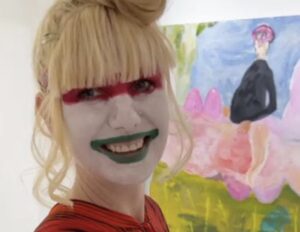
OD – It takes courage to engage with an unknown scene, a new painting. What do you hold on to? How do you begin? How do you finish?
JH – I used to worry about this but now i’ve been painting for 20 years I have a word with myself at the beginning that it always works out in the end. Sometimes I over paint and this can be quite frustrating as I will have taken a picture half way through and look back and think I should of stopped there but my heart, my passion and repulsion. wasn’t satisfied.
Sometimes I draw on the canvas in charcoal, sometimes I go in and attack with paint like a force, it gives me connection, it all depends on the mood that morning but the only way I know I’ve finished is to walk in the studio door, usually the day after and think yes that’s right. Lots of times I think its finished, I go home happy, only to be faced with something I think is totally rubbish the day after.
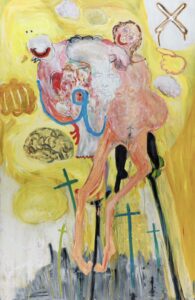
OD – in Framed you’ll show drawings and paintings. How do you see it the relation betweenthe two? What’s the function of drawing for you? Is it a preparation? A meen of investigation? A short cut? Does it ( the drawing) go back to the painting? What happens when you didact the color?
JH – I only started drawing again about 8 years ago, I totally lost the connection. I changed hands from left to right and it’s been a real breakthrough, I didn’t even know my right hand could draw, so I now mainly draw with my right, I paint with both.
I can sometimes get an idea down with a drawing when I’m in between a painting but also my drawing practice is a totally different practice. I can have a week of drawing just getting things out of my head, it frees me up I think and then I’m fresh and ready for a new painting. keeping it really basic with just pencil and sometime a little oil pastel usually one colour can also can be refreshing.
My drawings can be my most revealing work, me at my rawest, sometimes the most emotionally loaded but I rub a lot back and over layers help to create my finish.

The performance is the ridiculous or grotesque situations that occur in life with what people get away with, the masked figures are usually hiding something, or think they are, but it’s obvious to the viewer they’re up to something.
OD – There’s a sence of drama too, it feels like your figures are acting for the viewer, exhibitionists, yet shy… sometimws masked (I have in mind “Bubbelgum Base” which I love). How do you see it? The dramatic element, the audience, the performance?
JH – It’s different every time I think, the performance is the ridiculous or grotesque situations that appear in life with what people get away with, the masked figures are usually hiding something or at least think they are but it’s obvious to see by the viewer they are up to something.
OD -At Framed we’re dedicated yo showing visual art and music simultaneously, thus emphasising mutual elements (Composition, Harmony), how do you think the musicality of your work? (if you do…) or posible relation to music?
JH – I see it all as the same, music is the poetry of life, I’ve always been in some kind of a band, I used the poems of Kirt Schwitters years ago to put them together with my own melody and music and performed them at his famous Merz Barn in Elterwater, the Lakes, Uk.
As for in the studio, I always work listening to classical music and opera, when I know a picture is close to an end, I put on Kate Bush or PJ Harvey, like a mini celebration and have a celebratory dance, luckily no one sees…

